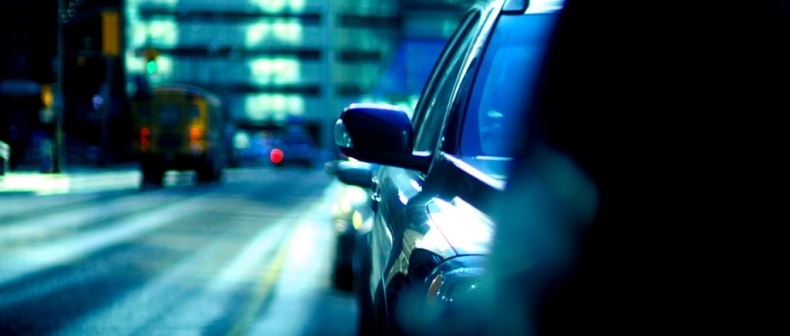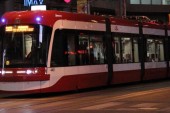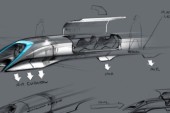
Image by Gadjo Cardenas Sevilla via Flickr
Charting a course to 2050 is going to be a daunting task for any city. Over the next few weeks, Justin Robertson will be placing a microscope on Toronto’s key industries and institutions that will be shaped by the predicted population growth facing the city in a series called “The Future of Our City.” The five-part series will examine how the city will be impacted by the aging population, the future of cars and transit and solutions to traffic congestion, and how the face of education and learning environments will change.
This week: We take a look at Toronto’s traffic epidemic and congestion challenges on the road and on transit, how futuristic cars could help ease congestion and how do we solve traffic congestion?
Speaking to any Torontonian they’ll tell you straight up: If you travel from one side of the city to the other in less than an hour either by car or public transit it’s considered a “win” or “good timing”. That’s a good day. On a bad day you can expect times to escalate on congested roads or delayed trains to soar above 90 minutes. The problem is on most occasions you have to zig-zag, back track and find the fastest route (which may not be the fastest route) in order to get from A to B. Collisions on our roads (when they happen) make matters worse, so too, construction. By car, the average Torontonian spends seven hours a week commuting. That adds up to 364 hours annually. With the city filling up with people, Toronto’s infrastructure is being strangled and is at capacity. So how do we fix the city’s congestion epidemic, where infrastructure needs augmenting but has to meld with a skyrocketing population?
Toronto’s city planner, Jennifer Keesmaat said, 20 years ago there was a call to do something about the city’s transit system based on data that showed there would be an increase in commute times. “Look at it now? It came true,” she said. “Now, the exact same situation is being predicted for the future and we haven’t increased infrastructure in any way. If we don’t invest, we will only see congestion challenges increase.” Keesmaat concedes, city politics has slowed progress to execute a master plan of cycling networks that is necessary to alleviate some of the city’s urban clogging. A recent study ranked Toronto the ninth most congested city in North America and according to the Ontario ministry of finance, population of the GTA will increase by 2.8 million, or 44.6 per cent, to reach almost 9.2 million by 2036. What the city should be shooting for, Keesmaat said, is a plan that includes an expansion across all modes of transit — more particular, our transit system and cycling networks.
“We need a multi-layered approach. We need to shift the mode. Cycling is low impact, it costs less and is environmentally sound. It doesn’t beat up infrastructure,” she said. “We are not always going to cycle everywhere so we need to have options — cycle, walk, transit, car.”
The shift into different modes of transport, according to Keesmaat, means investing in existing infrastructure such as the Downtown Relief Line and envisioning a future that involves using three or four types of urban movement. A future reality could well be this scenario: You wake up. Check your pocket device for the latest traffic update. It’s too congested on the roads you are told. So you chose to cycle. You enter your start and final destination. The device tells you the best route to take, taking into consideration the most and least congested areas. But some days, cycling routes may be too congested. So taking transit or car might be the best option. And this study revealed investing in cycling safety might be a good idea: it concluded that cycling infrastructure can reduce cycling injuries by half. “A huge part of the future of transport modes is having a choice. Choosing what to do and having the information available to make that choice,”Keesmaat said. “There’s a concern in this city that it’s dangerous to cycle downtown without protected bike lanes. We need to shift that.”
This week TTC CEO Andy Byford told the Toronto Star, based on their latest downtown relief line report, a relief valve should be the next expansion priority to avoid a nightmarish scenario. A view shared by Keesmaat. The study revealed The Yonge-Spadina subway line already carries 30,000 commuters during the morning rush hour and that these numbers will only increase if nothing is done about it. Tim Hudak’s talk of building subways “when the funds become available” as a solution to traffic reduction is full of hot air. We all know he was part of the government that filled in an under construction subway on Eglinton in the 90s. Why would we take him seriously now? Earlier this year Doug Ford complained he was trapped behind a streetcar while trying to get downtown in his vehicle. Should he not have been on the streetcar instead of in his car? That’s why streetcars exist in the first place, right? Both Hudak and Ford have acknowledged Toronto has a traffic problem, but their notion on how to fix it is inverted. And we, as a city, need to be moving forward. It certainly pays homage to the fact that the current city government is still fixated on car dependency. Doug Ford wants to add more lanes on the Gardiner and finance them with tolls — how would you even do that?
Image by Daily Grind Photography via FlickrSo where to from here? How do we tinker with the existing urban framework that will construe the expected population growth and congestion the city is confronted with?
One of the biggest hold-ups that is preventing Toronto forging ahead to reduce congestion, according to architect, Richard Witt, is that the city is still too car dependent. “The city is designed for conditions that are not flexible in use and that is part of our problem and the lack of investment in infrastructure is shocking, “ he said. “We are still a car dependent city. Even if we are suddenly driving clean cars, we still won’t be able to manage the load.”
Witt was recently part of the Charette series that focused on how to cope with a growing metropolis across North America. His presentation on shared spaces dealt with how to increase connectivity and emphasized Toronto’s transport mode wretchedness. What he is championing for is an adaptable city that alternates by day, night and seasonally. Imagine this on Queen Street West as an example: in the Summer months, it could be used for cyclists only and pop-up cafes; come Winter, it could return to single occupancy use for vehicles. This notion, Witt said, could be applied to “time of day” as well. “I do a lot of work in India and China. Shanghai, has a train connection from the airport to the city. The train travels at 430kph. I live in High Park and we’re talking about whether or not we should have a diesel train [for Metrolinx’s Air Rail Link]. We are just so far behind,” he said. “We have lots of people in the city with individual visions, but we don’t have a collective vision.”
The idea of building more roads to accommodate more traffic and cars is completely backward. The more roads we build, the more traffic we’ll accumulate which will lead to further congestion. We can scratch that. Road expansions should have been dealt with decades ago. Consider this: According to Witt, Toronto has added, something like, one road lane since 1948. Why would the city start expanding roads now? But vehicles do have a role to play in the future when in reducing traffic congestion. Daniel Flores, a spokesperson for General Motors, said within the next decade or so, the automobile industry will see an influx of car safety technology that will help shape traffic conditions. We’ll soon start to think of cars as computers on wheels with these inclusions: sensor-based technology where vehicles will be able to see a full 360 degrees around itself; “super cruise” mode considered the most advanced form of cruise control; and “vehicle to vehicle” technology, a radio frequency that emits signals to other cars almost as if they are talking to each letting them know where they are and how fast they are going. “Right now we have the building blocks for semi-autonomous vehicles moving forward and self-driving cars. We anticipate safer driving, less crashes and better driving efficiency,” he said. “It’s not the silver bullet, but it will help ease the flow of traffic and cut back congestion.”
If you take a look at other cities, investing into infrastructure and planning better is the ticket. Take Amsterdam as an example. Instead of devoting all of its six lanes to cars, the city made room for transit, wider sidewalks and separated bike lanes. Their vision is based on mixed-use surfaces and building communities where you can walk, cycle and take transit. They’re communities not built for the automobile, although vehicles can drive through them. This is a model Toronto should be setting its sights on; investing in an assortment of transport modes that doesn’t involve constructing new roads tailored for cars.
Next week: Part III: the future of urban learning environments and how the face of education will most likely change.
____
Justin Robertson is a freelance journalist from Toronto. His work has appeared in The Walrus, National Post and Toronto Standard. Follow Justin on Twitter @justinjourno
For more, follow us on Twitter @TorontoStandard and subscribe to our newsletter.














